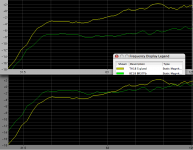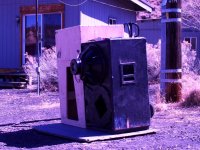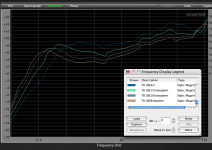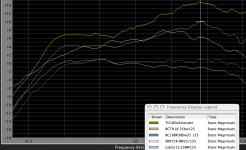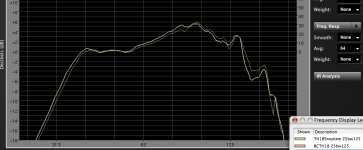Just finished a tapped horn for a B&C 18SW115-4, an incredible speaker that works well in a variety of TH and BR alignments.
During the course of testing and a few accidents, I have fed up to 120 volts of sine wave tones to the speakers, they did not sound distressed at that level. At 46v at 20 Hz, the cone has 50 mm peak to peak travel, and had just a hint of “clicky” sound.
I’m calling it the “Keystone” TH, the exit is shaped like a keystone. Dimensions are 45 x 26.5 x 22.5 inch, 15.5 cubic feet (440 liters) external volume.
I had an old BR cabinet 36 x 24 x 17.5 inch, 8.75 cubic feet (248 liters) external volume. Using a large port, 7.25 x7.25 x 9.75 deep with a 13.25 diameter round flange on the inside results in a 37 Hz Fb, a close match to the TH’s LF corner frequency and excursion minima.
Several lower tunings were tried before a match was found, cutting off 1 inch of the port at a time, the port started over 12” long. The “top hat” port tunes lower than a normal “tube” port.
Cabinet braces prevented the speaker to be mounted with the deep magnet structure inside the cabinet, so the cone was mounted “backwards”, effectively increasing the cabinet volume by about 15 liters over a “normal” mounting.
Maximum excursion is about the same for a given voltage for both the TH and the BR, though the TH excursion is far lower for most of it’s range.
In listening tests with both cabinets equalized to have the same frequency response and output, the primary difference was the port noise in the BR when pushed to the amp’s limit.
When the TH was pushed to the amp’s limit, it was basically noise-free, and 6 dB louder than the BR.
The top screen shots shows the Keystone TH and the BR cabinet at the same drive level, the lower screen shows the BR with 6 dB added, the level it would be if two cabinets with double the power were used.
Two of the ported cabinets would use slightly more truck space than the Keystone TH.
Using twice the amp power, it would take two of the BR cabinets to equal the level of the TH above 63 Hz, the BR would put out about 2 dB more below 50 Hz prior to port compression setting in at higher levels.
If the pair of BR cabinet size was reduced to the size of the single TH, their output would probably be almost identical.
The TH, requiring half the speakers and power for the same output, is a clear winner over BR.
The Keystone TH design also allows for extended LF response (at the expense of reduced upper response) by covering the mouth. The response curves with the exit height reduced to 15, 10, and 8 inches are shown.
Pictures, plans, and more information are available in this thread:
Keystone Sub Using 18, 15, & 12 Inch Speakers - diyAudio
Art
During the course of testing and a few accidents, I have fed up to 120 volts of sine wave tones to the speakers, they did not sound distressed at that level. At 46v at 20 Hz, the cone has 50 mm peak to peak travel, and had just a hint of “clicky” sound.
I’m calling it the “Keystone” TH, the exit is shaped like a keystone. Dimensions are 45 x 26.5 x 22.5 inch, 15.5 cubic feet (440 liters) external volume.
I had an old BR cabinet 36 x 24 x 17.5 inch, 8.75 cubic feet (248 liters) external volume. Using a large port, 7.25 x7.25 x 9.75 deep with a 13.25 diameter round flange on the inside results in a 37 Hz Fb, a close match to the TH’s LF corner frequency and excursion minima.
Several lower tunings were tried before a match was found, cutting off 1 inch of the port at a time, the port started over 12” long. The “top hat” port tunes lower than a normal “tube” port.
Cabinet braces prevented the speaker to be mounted with the deep magnet structure inside the cabinet, so the cone was mounted “backwards”, effectively increasing the cabinet volume by about 15 liters over a “normal” mounting.
Maximum excursion is about the same for a given voltage for both the TH and the BR, though the TH excursion is far lower for most of it’s range.
In listening tests with both cabinets equalized to have the same frequency response and output, the primary difference was the port noise in the BR when pushed to the amp’s limit.
When the TH was pushed to the amp’s limit, it was basically noise-free, and 6 dB louder than the BR.
The top screen shots shows the Keystone TH and the BR cabinet at the same drive level, the lower screen shows the BR with 6 dB added, the level it would be if two cabinets with double the power were used.
Two of the ported cabinets would use slightly more truck space than the Keystone TH.
Using twice the amp power, it would take two of the BR cabinets to equal the level of the TH above 63 Hz, the BR would put out about 2 dB more below 50 Hz prior to port compression setting in at higher levels.
If the pair of BR cabinet size was reduced to the size of the single TH, their output would probably be almost identical.
The TH, requiring half the speakers and power for the same output, is a clear winner over BR.
The Keystone TH design also allows for extended LF response (at the expense of reduced upper response) by covering the mouth. The response curves with the exit height reduced to 15, 10, and 8 inches are shown.
Pictures, plans, and more information are available in this thread:
Keystone Sub Using 18, 15, & 12 Inch Speakers - diyAudio
Art
Attachments
Last edited:
We found very similar results with our version of the Tham loaded with 18Sound 15WL1401's. We feed them 1Kw each and we haven't seen any problems. That's why I still believe Xmax is a pitty to use as limit with modern (expensive) drivers...Maximum excursion is about the same for a given voltage for both the TH and the BR, though the TH excursion is far lower for most of it’s range.
The 3015LF is almost exactly that sensitivity in a ported box of similar size.
Oh well.
When the TH was pushed to the amp’s limit, it was basically noise-free, and 6 dB louder than the BR.....
The TH, requiring half the speakers and power for the same output, is a clear winner over BR.
Art
Thanks,design looks neat.
do you have some more pics of it?
I'm waiting to take more pictures until finishing the second cabinet and they are painted and have grills.
No pictures yet.I'm interested in the path and folds for your TH if you have pics/diagrams, thanks.
Horn path is very simple, other than the braces it only requires three parts.
First 180 degree bend is at the bottom center (approximately) of the cabinet, next 90 degree bend back top, next 90 degree bend top front, then down to the Keystone shaped exit.
We had this discussion a long time ago.
If you can obtain optimum drivers -- which may be impossible for a reflex due to the required parameters -- and fit a noise-free port in -- ditto -- then a reflex of the same size as a TH has pretty much the same efficiency and cutoff frequency and maximum SPL for the same Xmax.
You may need 2 18" drivers in a reflex with difficult-to-build lighter cones and coils (still with enough Xmax) to get the similar results to one heavy-duty 18" driver in a tapped horn, but if you can't see what's inside the box the results will be very similar.
Either way, a the optimum driver (or drivers) for a reflex will have very different parameters to the optimum driver for a tapped horn. Put one into the other type of box and the results will be poorer -- this is what is shown in the comparison.
Even Tom's original patent shows this; a tapped horn lets you use drivers with less total volume displacement (Sd*Xmax) which may be a lot easier to obtain.
And it doesn't suffer from port compression, unlike many (most?) reflex boxes.
But in the ideal case a TH and a reflex are pretty similar seen as a black box.
(however you can probably build close to the "ideal" TH where you can't build close to the "ideal" reflex)
I agree with all you said, although in the case of the BC18SW125, this is a cone that works great in both BR and TH, but is about 6 dB more sensitive in the TH, it is still around 3dB more sensitive than two would be in the same size BR cabinet. Talking about efficiency without regard to directivity gets to be a little more dicey, the Keystone is showing more directivity above 60 Hz or so than BR, as shown in a recent post.
My Lab 2 x 12" cabs have good low end response, but I wanted more upper end to allow a higher crossover point for the 8 inch speakers used above them, after much consideration I made the leap of faith and designed and built some tapped horns.
I have included another chart below, all are at the same drive level, using 25 & 125 BW filters except the TH with extender, which had a 20 and 1K BW filter. The Lab 2x12" is nominally 3 ohms, and exactly half the size of the Keystone TH.
The others are nominally 4 Ohms, the JBL SRX 728 is a bit larger than the TH. The Keystone TH with the extender disassembled for transport would be about the same size as the 728.
The BC BR is the same cabinet in the OP, with the cone put in "normally", which raised the FB by about 1 Hz, and made the response almost perfectly flat.
Art
My Lab 2 x 12" cabs have good low end response, but I wanted more upper end to allow a higher crossover point for the 8 inch speakers used above them, after much consideration I made the leap of faith and designed and built some tapped horns.
I have included another chart below, all are at the same drive level, using 25 & 125 BW filters except the TH with extender, which had a 20 and 1K BW filter. The Lab 2x12" is nominally 3 ohms, and exactly half the size of the Keystone TH.
The others are nominally 4 Ohms, the JBL SRX 728 is a bit larger than the TH. The Keystone TH with the extender disassembled for transport would be about the same size as the 728.
The BC BR is the same cabinet in the OP, with the cone put in "normally", which raised the FB by about 1 Hz, and made the response almost perfectly flat.
Art
Attachments
Thank you!
Just did another test yesterday, removed a cover plate that reduced the cone area to the same area as S2.
The Keystone performs slightly better without the plate, and excursion stayed the same or lessened.
The screen below shows the Keystone with and without the cover plate, 25 and 125 BW filter applied, no EQ.
Just did another test yesterday, removed a cover plate that reduced the cone area to the same area as S2.
The Keystone performs slightly better without the plate, and excursion stayed the same or lessened.
The screen below shows the Keystone with and without the cover plate, 25 and 125 BW filter applied, no EQ.
Attachments
Hey Art,
Can you describe the "extender" ?? If I read your plot correctly, it looks like it adds ~3dB across the entire spectrum, certainly a worthy addition if one is looking for max SPL.
Also, I would love more LF extension. When you cover some of the port to get more extension, what happens to the excursion in the mid-bass range? could I close the port to say 10 inch height, and then use EQ to raise the mid-bass response, or would that push the excursion too high in the 50 Hz range?
Thanks for the informative posts! Looks like an excellent project!
D
Can you describe the "extender" ?? If I read your plot correctly, it looks like it adds ~3dB across the entire spectrum, certainly a worthy addition if one is looking for max SPL.
Also, I would love more LF extension. When you cover some of the port to get more extension, what happens to the excursion in the mid-bass range? could I close the port to say 10 inch height, and then use EQ to raise the mid-bass response, or would that push the excursion too high in the 50 Hz range?
Thanks for the informative posts! Looks like an excellent project!
D
I agree with all you said, although in the case of the BC18SW125, this is a cone that works great in both BR and TH, but is about 6 dB more sensitive in the TH, it is still around 3dB more sensitive than two would be in the same size BR cabinet. Talking about efficiency without regard to directivity gets to be a little more dicey, the Keystone is showing more directivity above 60 Hz or so than BR, as shown in a recent post.
Art
I agree that the BC18SW115 is great in a TH; reference efficiency in a reflex is 94.7dB/W, so say 100.7dB/W in a TH (6dB more efficiency and maximum SPL) -- and 2x BC18SW115 in a reflex would only be 97.7dB/W, just as you said, so would need 2x the amplifier power to reach the same SPL as the TH.
However 2 BC18PS76 (reference efficiency 98.6dB each) would be 101.6dB/W in a reflex, and have a bit more volume displacement (2.2l vs 1.6l) than one 18SW115 -- this would be compensated for by the fact that the TH has a bit less maximum cone travel, so maximum SPL would be similar.
In other words a TH likes "modern" drivers such as the 18SW115 with high BL and moving mass and power density and power handling, and reflexes like "old-school" drivers with lighter cones, lower moving mass and power density such as the 18PS76 -- and usually 2 of them compared to 1 of the same size in a tapped horn.
So 2 18PS76 cost about the same as 1 18SW115, have about the same efficiency and maximum SPL, and weigh about the same in the same size box (2 drivers are heavier than 1, but TH box weighs more than reflex). Not much difference then
But there's no doubt that a TH is more suited to the modern high-power high-Xmax drivers which often need something to get their efficiency up, the manufacturers figures for dB/W are almost always optimistic (not the reference efficiency value).
Bass directivity should only be controlled by the radiating area (and shape) of the sound source, which is the TH mouth for the Keystone or the cones for a 2x18 reflex -- though a big front panel area can also help a bit. Unless you use a mouth extender for the Keystone I wouldn't expect the directivity to be much different (if the cabinet fronts are the same size), the radiating sizes are a small fraction of a wavelength even at 100Hz.
Last edited:
That is what I thought too, but the Keystone TH had quite a bit more directivity than the BR (about double) and a spiral horn cabinet, did you read my recent post with the directivity results ?Bass directivity should only be controlled by the radiating area (and shape) of the sound source, which is the TH mouth for the Keystone or the cones for a 2x18 reflex -- though a big front panel area can also help a bit. Unless you use a mouth extender for the Keystone I wouldn't expect the directivity to be much different (if the cabinet fronts are the same size), the radiating sizes are a small fraction of a wavelength even at 100Hz.
The horn cabinet has less frontal area than the BR, it was higher directivity than the BR.
The BR front panel is 36x24 inch the TH 45 x 26.5 inch, a ratio of 72.45/100.
The directivity increase was over double from the BR, so it is not just the front panel size at work.
That said, the extender doubles the TH frontal area, and doubles the directivity again.
However, putting the extender on BR or the horn cabinets has little effect below about 70 Hz.
The BR front panel is 36x24 inch the TH 45 x 26.5 inch, a ratio of 72.45/100.
The directivity increase was over double from the BR, so it is not just the front panel size at work.
That said, the extender doubles the TH frontal area, and doubles the directivity again.
However, putting the extender on BR or the horn cabinets has little effect below about 70 Hz.
Don't you mean that the BR has less frontal area than the TH? (your numbers)
So the TH has a bigger panel and all the sound comes out of the mouth near the ground. If you imagine the front panel reflected in the ground plane, the TH mouth is smaller and surrounded by more panel to confine the initial wavefront expansion to 180 degrees, so I expect this will increase directivity a bit.
If the reflex had the same size front panel with the drivers manifold mounted so the sound came out of a hole the same size and position as the TH mouth I expect you'd get exactly the same directivity, since the atmosphere has got no way of knowing what's inside the mouth.
So the TH has a bigger panel and all the sound comes out of the mouth near the ground. If you imagine the front panel reflected in the ground plane, the TH mouth is smaller and surrounded by more panel to confine the initial wavefront expansion to 180 degrees, so I expect this will increase directivity a bit.
If the reflex had the same size front panel with the drivers manifold mounted so the sound came out of a hole the same size and position as the TH mouth I expect you'd get exactly the same directivity, since the atmosphere has got no way of knowing what's inside the mouth.
Yes, the the BR front panel is smaller 36x24 inch, the TH 45 x 26.5 inch, a ratio of 72.45/100.
One other interesting wrinkle, putting the Keystone upside down messed with the upper response (peaky), but the lower response stayed the same.
Most of the LF output of the BR comes from the port, it is close to the ground, the rest of the panel and cone make up a panel only a bit smaller than the TH front.
One other interesting wrinkle, putting the Keystone upside down messed with the upper response (peaky), but the lower response stayed the same.
Most of the LF output of the BR comes from the port, it is close to the ground, the rest of the panel and cone make up a panel only a bit smaller than the TH front.
- Status
- This old topic is closed. If you want to reopen this topic, contact a moderator using the "Report Post" button.
- Home
- Loudspeakers
- Subwoofers
- Tapped Horn Vs. Bass Reflex Case Study
